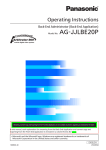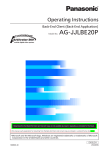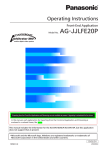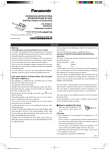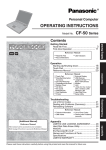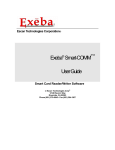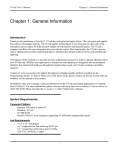Download Panasonic Arbitrator 360 Operating Instructions
Transcript
Operating Instructions Back-End Server/Back-End Streaming Server/Service Watch (Back-End Application) Model No. AG-JJLBE20P Back-End Streaming Server is not available at present. Upgrading is scheduled for the future. •M icrosoft and the Microsoft logo, Windows are registered trademarks or trademarks of Microsoft Corporation in the United States and other countries. ENGLISH 1009K0 -M VQT2D96 Contents Overview.................................................... 3 Operating Environment...................................................3 Installing/Uninstalling.............................. 4 Installing..........................................................................4 Preparation.................................................................4 Installing the Back-End Server application.................4 Installing the Back-End Streaming Server application...............................................................8 Uninstalling...................................................................10 Before uninstalling....................................................10 Uninstalling Procedures for Windows Server 2003...10 Uninstalling Procedures for Windows Server 2008...10 Startup..................................................... 11 Description of the Screen Display........ 12 Log Tab.........................................................................12 Service Tab...................................................................13 Monitoring the Back-End Server........... 14 Filtering.........................................................................14 Updating the Log list automatically..........................14 Updating the Log list manually.................................14 Deleting the log........................................................14 Cancel deleting........................................................14 Output the log...........................................................14 Log details....................................................................15 Service window.............................................................15 Error Message......................................... 16 For obtaining the software, contact your supplier. ■ Display in this manual Display on the screen may differ from the actual product. Back-End Streaming Server is not available at present. Upgrading is scheduled for the future. Overview Operating Environment Service Watch is a system to monitor the Back-End server and to record its operations as a log. Using this log, an administrator can watch the conditions of the Back-End server and plan maintenance. Service Watch can restart the Back-End server. A PC that meets the following operating environment is required for user of this application. CPU RAM OS : Intel Quad Core Xeon 5430 2.66 GHz or more : 2 GB or more : Windows Server 2003 Service Pack 2 or later Windows Server 2008 Standard Edition SP2 DB : Microsoft SQL Server 2008 Standard Edition Service Pack 1 Add on: .Net Framework 3.5 Service Pack 1 Adobe Reader 8 or 9 Installing/Uninstalling Installing Installing the Back-End Server application The Back-End application is installed with the following procedures. Each application can be installed on separate computers connected via a network. For installing the application, .Net Framework 3.5 Service Pack 1 and SQL server must be installed on the computer. 1. Click on the BESSetup.msi. The License Agreement screen appears 1. Install the Back-End Server application. 2. Install the Back-End Streaming Server Back-End Streaming Server is not available at application. present. Upgrading is scheduled for the future. Preparation 1. Download “.Net Framework 3.5 Service Pack 1” from the Microsoft download site. If .Net Framework 3.5 has been installed, update it. 2. Select “I Agree”. 2. Install the “.Net Framework 3.5 Service Pack 1” following the instructions. 3. Install the SQL server named “Microsoft SQL Server 2008 Standard Edition”. 4. Select the SQL Server certification. 5. Select the Full-Text Search. 6. Select the SQL Server Browser. 7. Install the SQL server. If the SQL server has been installed, new installation is not required. Update the SQL server. 8. Create a user account for an OS belonging to the Administrators group. Using the authority of this user, execute the BackEnd Server. The user is exclusive for executing the Back-End Server. Do not delete this user, user name, or password. 3. Click on [Next]. 9. Login the OS with the new user and install the Back-End Server, following the steps in “Installing the Back-End Server application.” After installation, the Back-End Server operates with the Local System account. For changing the user account, see “Service Tab,” page 13. Installing/Uninstalling (continued) 4. Click on [Next]. 6. Click on [Next]. The file will be transferred to the following folder: /Program Files/Panasonic/BES The screen shown below appears. When the file transfer is completed, the screen shown below appears. 7. Select the SQL Server from the dropdown list. For referring the SQL server that can be currently connected, click on [Reference]. If the SQL Server name is not displayed on the dropdown list, SQL Server Browser services may not be activated. Follow the procedures below to activate the SQL Server Browser services, then click on [Reference] again. 1.Click on [Start]. 2.Select Control Panel. 3.Double-click on Administrative Tools. 4.Double-click on Services. 5.Right-click on the SQL Server Browser services then click on Start. 5. Enter the License ID and Password. Installing/Uninstalling (continued) 8. Select “SQL Server authentication”. Initial data setting: For specifying the saving path for various data For SQL Server authentication, a user name and password of a user for the SQL server having sysadmin authentication is required. To use the Windows authentication, the installer should be started by a user having administrator authority. Video InBox path: For temporarily saving video files before registering the database Default Library path: For saving video files Unprocessed Video path: For saving unprocessed video files Archive path: For saving archive files Free field setting: For naming of five fields used as metadata Naming the fields The name defined in the free field setting will be displayed on the Front-End application, Back-End Client application, and Back-End Administrator application. Up to 50 characters can be used in a field name. Field1: For defining the name of Field1 Field2: For defining the name of Field2 Field3: For defining the name of Field3 Field4: For defining the name of Field4 Field5: For defining the name of Field5 (Use the name, such as Source or Vehicle, because the system uses Field5 for distinguishing vehicles.) 9. Enter the same user name as that used for installing the SQL server. Note 10.Enter the same password as that used for installing the SQL server. The name set here cannot be changed in the application. 11.Click on [Next]. The screen shown below appears. 12.Set the settings and path if necessary. 13.Click on [Next]. The screen shown below appears. 14.Enter the SMTP Server address in SMTP Server field. (For details, refer to the Operating Instructions for the Back-End Administrator application.) Database server setting: For specifying to save the database file 15.Enter the Port Number. Normally use the default setting “25.” Installing/Uninstalling (continued) Setting the SMTP Server 16.Click on [Register]. The registration success dialog box appears. If the SMTP setting has been canceled or the SMTP Server is intended to be set later, follow the procedures below. 1. Double-click on SMTPSetting.exe in the folder shown below where the Back-End Server has been installed. C:\Program Files\Panasonic\ICV\BES\ SMTPSetting.exe The screen shown below appears. 17.Click on [OK]. The screen shown below appears. 2. Enter the address of the Back-End Server, User ID, and Password. 3. Click on [Connect]. 18.Click on [Close]. Installation is completed. Once installation is completed, the service will start. The service will be activated once the OS has started up. 4. Follow steps 14 to 18 above. Installing/Uninstalling (continued) Installing the Back-End Streaming Server application 4. Click on [Next]. The file will be transferred to the following folder: /Program Files/Panasonic/BESS To install the Back-End Streaming server application, the Back-End Server application should be installed. 1. Click on the BEStreamingSetup.msi. The License Agreement screen appears. When the file transfer is completed, the screen shown below appears. 2. Select “I Agree”. 5. Select the SQL Server that is used with the Back-End Server application from the dropdown list. 3. Click on [Next]. For referring the SQL server that can be currently connected, click on [Reference]. If the SQL Server name is not displayed on the dropdown list, SQL Server Browser may not be activated. Follow the procedures below to activate the SQL Server Browser, then click on [Reference] again. 1.Click on [Start]. 2.Select Control Panel. Back-End Streaming Server is not available at present. Upgrading is scheduled for the future. Installing/Uninstalling (continued) 3.Double-click on Administrative Tools. 4.Double-click on Services. 5.Right-click on the SQL Server Browser services then click on Start. 10.Select the Back-End Server that will be linked with the Streaming Server from the list. 11.Specify the IP address of the Streaming Server for being accessed by the Back-End Client. 6. Select “SQL Server authentication”. 7. Enter the same user name as that used for installing the SQL server. 12.Click on [Complete]. The screen shown below appears. 8. Enter the same password as that used for installing the SQL server. 13.Click on [Close]. Installation is completed. 9. Click on [Next]. The screen shown below appears. Back-End Streaming Server is not available at present. Upgrading is scheduled for the future. Installing/Uninstalling (continued) Uninstalling Uninstalling Procedures for Windows Server 2008 Uninstall the Back-End Server application and BackEnd Streaming Server application following the procedures below. 1. Click on [Start]. 2. Select Control Panel. Before uninstalling 3. Double-click on Programs and Features. Before uninstalling the Back-End Server and Back-End Streaming Server, be sure to stop them. 4. Select the program to be uninstalled. The Uninstall or change a program window opens. 5. Click on Uninstall. 1. Start the Service Watch. The User Account Control window opens. 2. Click on the Service tab. 6. Click on [Continue]. The Uninstall window opens. 7. Click on [Uninstall]. Uninstalling of the selected program starts. 3. Click on [Stop] in Back-End Server section to stop the Back-End Server. 4. Click on [Stop] in Back-End Streaming Server section to stop the Back-End Streaming Server. Uninstalling Procedures for Windows Server 2003 1. Click on [Start]. 2. Select Control Panel. 3. Select Add or Remove Programs. The Currently installed programs window opens. 4. Select the program to be uninstalled. 5. Click on [Remove]. A confirmation message appears. 6. Click on [Yes]. Uninstalling of the selected program starts. Back-End Streaming Server is not available at present. Upgrading is scheduled for the future. 10 Startup 1. Turn on the PC and the Memory Card Video Recorder. 2. Click on the Service Watch icon on the desk top. The Service Watch screen is displayed. 11 Description of the Screen Display When the Service Watch icon on the desktop of the PC is clicked on, the screen shown below appears. Log Tab Event Type The logs are filtered according to Event Type. Setting values: Success, Error, No filtering Default setting: No filtering Event Category/ID The logs are filtered according to Event Category/ID. Setting values: No filtering, Disk, Network, Service/Add to library, Service/Upload or Import to Video Inbox, Service/Streaming, Service/Schedule, Service/BEC Default setting: No filtering Start Date The logs are filtered according to Start Date. If the check box is checked, this filter is activated. Default setting: No check End Date The logs are filtered according to End Date. If the check box is checked, this filter is activated. If unchecked, the Logs list will be updated in real time. Default setting: No check Log tab For displaying the Log list and setting the filtering conditions. Service tab Start Time For displaying the service information. (See “Service window” on page 15.) The logs are filtered according to Start Time. If the check box is checked, this filter is activated. Default setting: No check Delete button Click on this button to delete the log on the Log list. End Time The logs are filtered according to End Time. If the check box is checked, this filter is activated. If the check box is unchecked, the Log list is updated in real time, and the latest log is displayed on the Log list. Default setting: No check Output button Click on this button to output the Log list as a text file. Log List Shows the logs of the Back-End Server operations after being filtered. The list will be updated in real time if End Time is unchecked. If you double-click on an item, the Information screen for that item will be displayed. (See “Log details” on page 15.) Auto Update When the check box is checked, the Log list is updated automatically. Update button Click on this button to update the Log list manually. Log Filtering For specifying the filtering conditions. Close button For closing the Service Watch screen. Back-End Streaming Server is not available at present. Upgrading is scheduled for the future. 12 Description of the Screen Display (continued) Service Tab Stop button Back-End Streaming Server is not available at When this button is clicked, the Back-End present. Upgrading is scheduled for the future. Streaming Server stops. Close button When this button is clicked, the Service Watch stops. Help button When this button is clicked, Help is displayed. Stop button When this button is clicked, the Back-End Server stops. Local System account option button Select to use the Local System account. The Back-End Server is activated with the Local System account. This is the default setting. The user specified in the Local System account has the same authority as the members in the Administrator group. This account option button Select to use this account. When this account is selected, Account and Password should be set. Select to set the user account for activating the Back-End Server. After selecting this option button, input the user account and password, confirm the password, then click on [Change]. Account Set the account. Password Enter the password. Confirm password Reenter the password to confirm it. Change button When the setting in Back-End Server section is changed, click on this button. 13 Monitoring the Back-End Server Filtering 2. Click on [Yes]. All log data on the Log list are deleted. Collected logs are filtered according to the conditions set in the Log Filtering section, and only the filtered logs are displayed on the Log list. Cancel deleting Click on [No] on the confirmation dialog box. Setting the filtering conditions Set the filtering conditions following the procedures below. Output the log 1. Select the Event Type from the dropdown list. 1. Click on [Output]. 2. Select a folder in which to store the log file then enter the log file name. 2. Select the Event Category/ID from the dropdown list. 3. Click on [OK]. The log file is created in the specified folder. 3. Set the Start Date from the dropdown list, and check the check box. If the Start Date is not to be used for filtering, uncheck the check box. 4. Set the End Date from the dropdown list, and check the check box. If the End Date is not to be used for filtering, uncheck the check box. 5. Set the Start Time from the dropdown list, and check the check box. If the Start Time is not to be used for filtering, uncheck the check box. 6. Set the End Time from the dropdown list, and check the check box. If the End Time is not to be used for filtering, uncheck the check box. Updating the Log list automatically Check the Auto Update check box, and the Log list will be updated automatically. Updating the Log list manually Click on [Update]. The Log list is updated. Deleting the log 1. Click on [Delete]. The confirmation dialog box appears. 14 Monitoring the Back-End Server (continued) Log details Service window Double-clicking on an item on the Logs list displays the Information screen to show the details of each log. Click on the Service tab on the main window. The Service window appears. To see the details of the previous log Click on [Prev]. To stop the Back-End Server Click on [Stop] in the Back-End Server section. To see the details of the next log Click on [Next]. To stop the Back-End Streaming Server Back-End Streaming Server is not available at Click on [Stop] in the Back-End Streaming Server present. Upgrading is scheduled for the future. section. To close the Information screen Click on [Close]. To restart the application Click on [START]. Note Only the administrator of the server can stop and restart the application. 15 Error Message Message Measure “Cannot start BackEnd Server. Please contact to the administrator." The Back-End server cannot start. Check whether the logged-in user has administrative privileges. “Cannot start Streaming Server. Please contact to the administrator.” The Streaming Proxy server cannot start. Check whether the logged-in user has administrative privileges. “Cannot stop BackEnd Server. Please contact to the administrator.” The Back-End server cannot be shut down. Check whether the logged-in user has administrative privileges. “Cannot stop Streaming Server. Please contact to the administrator.” The Streaming Proxy server cannot be shut down. Check whether the logged-in user has administrative privileges. Back-End Streaming Server is not available at present. Upgrading is scheduled for the future. 16 Panasonic Computer Solutions Company 50 Meadowlands Parkway, Panazip 2F-5, Secaucus, NJ 07094 © 2009 P

















